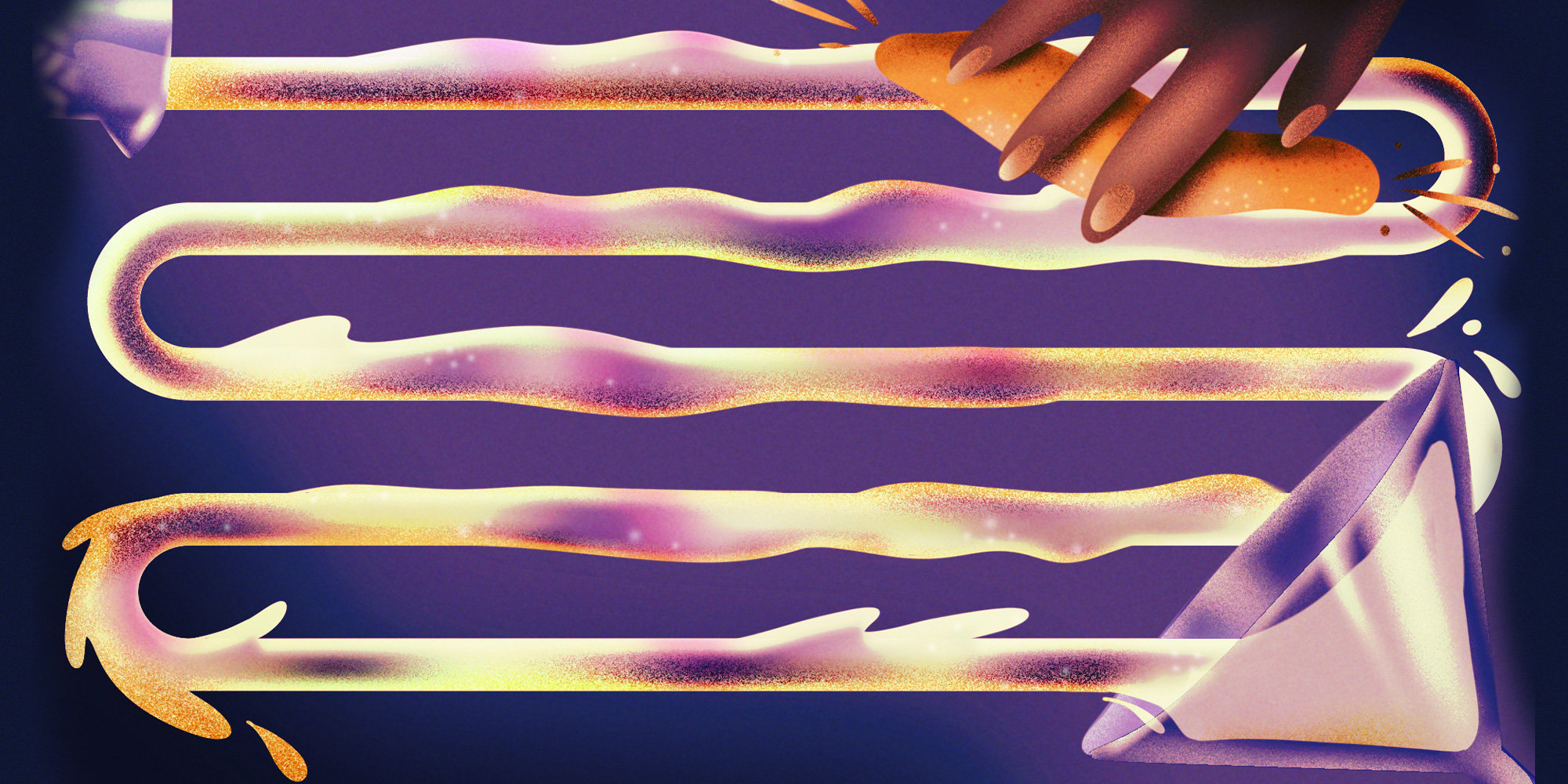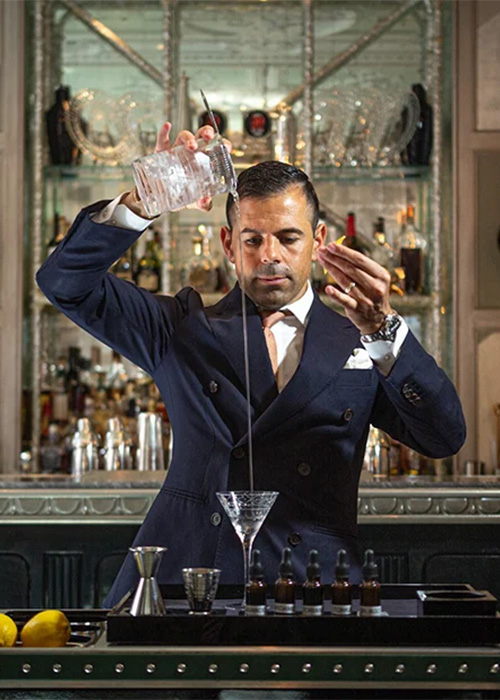


Hanky Panky‘s Gina Barbachano is a magician behind the bar, displaying a well-honed level of grace as she shakes a cocktail tin in her left hand while stirring two others with separate mixing spoons in her right. When it comes time to serve one of those stirred drinks, she puts forth an elegant show, extending the tin far into the air — a foot, two feet, a full arm’s reach — over the glass she’s filling for an elongated, high pour. In her other hand, she repeatedly expresses a citrus peel with the flourish of a waving motion straight into the drink’s pouring stream, providing a robust, aromatic citrus shower for the cocktail.
You’ve seen this before. Probably at your favorite high-end cocktail joint. A few years ago, it was a rarity. Today, it’s ubiquitous. The “high pour and citrus spritz” (HPCS), as we’re calling it, has taken over the cocktail world.
Its innate, chic style and pizzazz, combined with its pure efficacy, provided the spark for the technique to be passed on from one bartender to another, now taught in-house as standard practice in many establishments, a game of reverential cocktail copycat that’s played out before our very eyes and spread across the world. While it’s often tricky to pin down where or how a trend picked up momentum with precise accuracy, in this case, it’s obvious.
“A lot of people call it ‘The Connaught Style,’” Barbachano says. “Yeah, I think The Connaught are the ones who popularized that.”
Such is the power of The Connaught‘s renowned Martini trolley service that the signature HPCS serve has moved beyond its swanky confines and entered the bar world at large, its presence in the cocktailverse only continuing to increase.
“For us it was a natural evolution of The Connaught Martini service that was already revolving around an experience of flair. Plus, Ago had his fair share of flair bartending training at the beginning of his career, so that played a role, too.”
“The Connaught Martini high pour came as a natural and continuous evolution of our service,” says Agostino Perrone, The Connaught’s director of mixology. He describes the bar’s approach to hospitality and drink making as personalized and participatory for the guest. The pour is the icing on the cake — or the olive in your glass, perhaps. “The high pour is the final, theatrical close to a play that is co-written with our guests.”
The continued mastery of the HPCS is no mistake. None of it is by accident. It is a learned and practiced technique for the expert bartender, a sharpened weapon to have in their personal arsenal. “It’s part of our set of core technical skills,” says Giorgio Bargiani, The Connaught’s assistant director of mixology. “Our team members are trained to learn and own the technique with confidence and flair. Before The Connaught Martini high pour can be performed in front of a guest this needs to be mastered. It has to be flawless.”
It’s this pursuit of perfection that helps transform a world-class bar into a global sensation, as well as the type of inside-baseball bartending published in a glossy tome such as “The Connaught Bar: Cocktail Recipes and Iconic Creations.” The book, penned by Perrone along with Bargiani and Maura Milia, was released this April, the culmination of The Connaught’s journey since its debut in 2008.

In addition to the cocktail recipes and assorted graduate-level cocktailing discourse, the book showcases the HPCS, unnamed, in its instructions for The Connaught Martini: “Strain into the prepared Martini glass, raising the mixing glass high to add aeration to the drink and squeezing the lemon twist into the drink as the liquid passes into the glass.” It’s an accurate mechanical walk-through, but hardly captures its transcendent allure.
“We’ve always been sharing our knowledge and practices with peers and cocktails lovers all over the world, so we’re very pleased when we see people replicating or referencing our signature high pour. It means we’ve been inspiring and delighting them, and this is our greatest professional reward.”
Published book or not, there may not be definitive proof that The Connaught was the absolute first practitioner of its now eponymous pour. Of course, there were rectangular, full-screen phones that looked and functioned pretty damn similarly to what would come to be known as the iPhone before that particular device appeared on the scene. But there’s no doubting what birthed the movement that followed in its tracks.
“It’s hard to pinpoint if anyone has ever done it before us, but we can certainly say we made it popular,” Bargiani says. “For us it was a natural evolution of The Connaught Martini service that was already revolving around an experience of flair. Plus, Ago had his fair share of flair bartending training at the beginning of his career, so that played a role, too.”
It’s not pure showmanship, though. There are benefits to deploying the technique as well. “You want the vermouth to breathe, you want it to have air,” Barbachano says. “Some things also work better when you aromatize the whole drink, not just the top of it.” She believes it aerates the drink but not to the extreme degree that throwing it would. If stirring, throwing, shaking, dry shaking, and reverse dry shaking each have their place in the realm of drink production, the HPCS is but another piece of methodology applicable to a very specific situation.
As for its current omnipresence, The Connaught crew has nothing but love for the early adopters who first picked up their tricks, and the masses that have followed since. The HCPS spread like wildfire across cocktail hotbeds such as London, New York, and Tokyo. I’ve seen it deployed everywhere from Singapore to Scandinavia, and from Bali to the Baltics. There’s no doubt you’ll find a few examples far and wide with just a quick scroll of your socials, and some very high pours amid some very un-Connaught-appearing aesthetics.
“Whatever you see about us has a genuine root in the essence of our bar and of our team’s dedication to hospitality.”
“We’ve always been sharing our knowledge and practices with peers and cocktails lovers all over the world, so we’re very pleased when we see people replicating or referencing our signature high pour,” Perrone says. “It means we’ve been inspiring and delighting them, and this is our greatest professional reward.”
Plus, with the spread of guest shifts, more of the world’s best and brightest bartenders are getting direct exposure to it. It’s not just something they see on Instagram; they’re experiencing it in person and having the likes of Perrone or Bargiani explain it to them. “We have been showcasing it for years, over seminars and masterclasses, and its popularity never seems to fade,” Perrone says.
What separates a fad from a bonafide movement is a combination of a legitimate, unforced surge with the staying power to outlast our tiny TikTokified attention spans. “Whatever you see about us has a genuine root in the essence of our bar and of our team’s dedication to hospitality,” Perrone says. “So, we truly believe that this authentic spirit has made it possible for our Connaught Martini high pour to become so popular.”
See it playing now in a bar near you.
The article How the Connaught Pour Conquered the Bar World appeared first on VinePair.